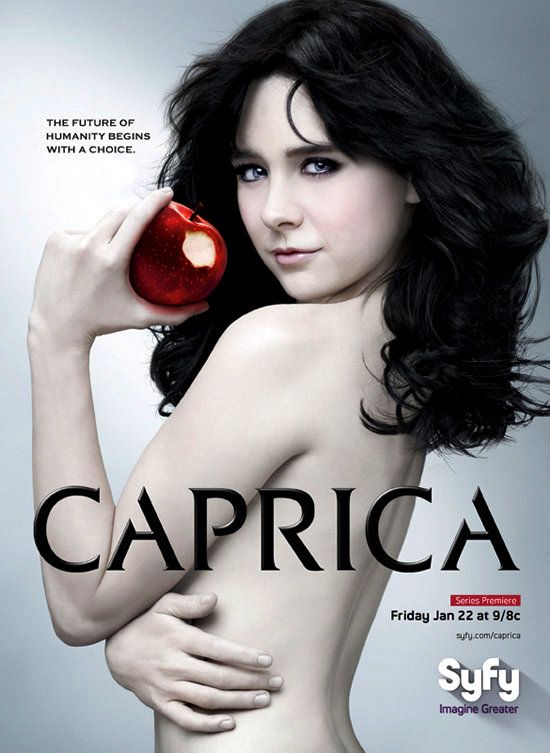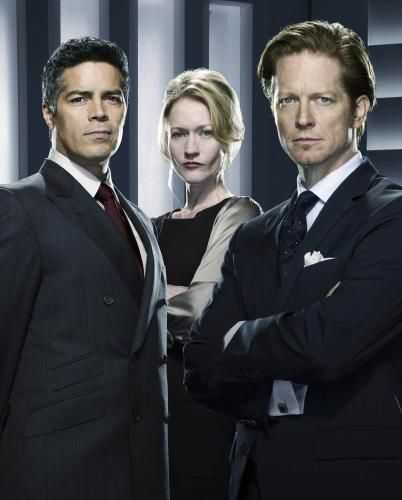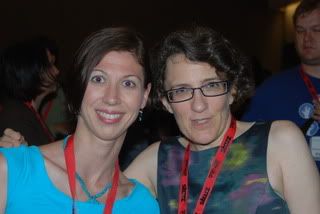
No one has been more excited about the premiere of Battlestar Galactica prequel Caprica than ScriptPhd.com. We eagerly joined the cast and crew of both shows last May during their joint panel at the Los Angeles Paley television festival. We were also one of the first sites to review the Caprica 2 hour pilot. And now, at long last, one of the most anticipated sci-fi prequels ever will premiere on the SyFy Channel this Friday. ScriptPhD.com’s Bryy Miller reviews the first three episodes and talks about the show’s early conceptualization and long-term promise. We are also extraordinarily fortunate and proud to bring you an Editor’s interview with series executive producer and show runner Jane Espenson, in which she talks about what we can expect from Caprica. Please click “continue reading” for full content.
REVIEW: Caprica
ScriptPhD.com Grade: B
The spin-off of SyFy ratings spectacular Battlestar Galactica has a lot in common with Shakespeare’s King Lear. Like King Lear, it is far more ambitious than any of Shakespeare’s previous works, both in scope and in depth (yes, even more so than Hamlet—but that’s for another article). In addition, it fleshes out the ensemble on a level far more fluid and psychological than what came before. But, as it turns out, being like King Lear is Caprica’s great flaw. The glitch, so to speak.
Caprica, for the benefit of new fans, is a follow-up to writer/producer Ronald D. Moore’s ambitiously verbose and successful science fiction series, Battlestar Galactica. Caprica’s main mission is to tell the creation story of the being that would one day become mankind’s greatest enemy, an artificial intelligence called the Cylon. Unlike other AI, these robots actually experience emotion and lead “full” lives. This, of course, will make for some rather interesting debates on the nature of intelligence, the soul, and war in general. Caprica takes place approximately 58 years before the events of Galactica, and while my brain is not scientific enough to compute if that is a short enough time span to encompass the full sequence of events, from the looks of it, they seem to be going at a realistic pace. In those 58 years, the Cylons don’t just sit around on the assembly line: they have to gain sentience, be mass produced, become a staple of everyday life, and start the FIRST Cylon war with humanity. Because there is quite a lot of story to tell, the central question is not whether the series is sustainable, but whether the story is worth telling.
Back to the Lear analogy. The thing about BSG was that, even though it possessed quite a large ensemble cast, it was plot-driven. Each character was essential to one overarching story, one goal. Caprica is not plot-driven. It is character-driven, and this is where it becomes a liability to be just like lil’ old King Lear. The writers of Caprica seem content to throw a lot of disparate characters all over the map doing completely different things and interweaving story arcs that feel as if a silk spider had gone to work on them. “It’s more about their personal lives,” admitted series creator/writer Jane Espenson at last year’s Paley event. “They don’t have the threat of death breaking down their neck every moment so that you can feel more lived in, you can explore this culture more.” Added Ronald D. Moore, “It’s a different show. I mean, losing the action-adventure is a risk…. [But] since there’s no Cylons coming in to sort of destroy the Galactica every once in a while, fate and humanity doesn’t hang in the balance yet.” Caprica writers even go as far as to make the main antagonist a polygamist, and give her family life a (sometimes bloated) spotlight. It’s as if they thought simply giving a character something to do would be high drama. Don’t even get me started on the subplot involving what seems to be an entire precinct of corrupt cops, three of which are introduced as part of the ensemble. My fears were not assuaged one bit when I saw that Ron Moore himself was on the writing staff. It may seem contradictory, me saying Ron Moore, the creator of a brilliant generation-defining show, writing for Caprica might be a bad thing. While he does a mean tap dance, Mr. Moore has a tendency to introduce plots into his shows without knowing what they have to do with said show. This is most apparent when he copped to not knowing where a pregnancy storyarc in BSG was going (among a human and Cylon, no less), and when he flat out stated that you don’t know where a season is going to end when you start writing it. This began many debates within the writing community if having a planned story versus on-the-fly writing mattered (the answer is, and always will be, yes). While initial publicity seemed to indicate that his involvement would be minimal, for Caprica’s sake, hopefully it is the Ron Moore of the earlier stages of Battlestar Galactica. It helps that the show is being helmed and written by equally brilliant BSG and Buffy the Vampire Slayer writer Jane Espenson.

Our story begins with Daniel Graystone (Eric Stoltz), genius inventor, man about town, owner of seemingly everything. He is Bill Gates 2.0, and unbeknownst to him, his daughter Zoe (Allessandra Torresani), is busy creating artificial life in the form of a digital clone. The very first scene in the series is also the most confusing and frustrating, because it takes place in an Internet 8.0 lab of hers. Picture a fully interactive Second Life, overpopulated with the bored, the rich, and the dumb—which is not fully explained to the viewers in any coherent manner for at least thirty minutes into the two-hour pilot. There is a lot to like about Caprica. Every single concept in Caprica’s world was superb. Amazing. Despite visual and thematic superiority as one would expect from the BSG team, there were problems with early conceptualization. Everything seemed to be told to the viewer three times: once in vague technobabble that is supposed to sound too smart for us, once in a truncated layman’s speak, and yet another in a sort of mystic and supernatural definition. The problem is not with the idea but with its execution. Zoe’s invention—the Amoeba of the Cylons—is basically a search engine that can find genetic data and turn that into… well… memory. RAM. Gigahertz. It’s a fantastic way to explain true AI, the only problem is that the writers do so through the steps outlined before.
Tragedy occurs. Telling would be spoiling, but needless to say, Zoe dies in an accident that not only takes the life of the daughter of Joe Adams (Esai Morales), father of Galactica’s future commander Bill Adama, but also stirs the show’s significant dialogue on monotheism and the Cylons’ embrace of a One True God. Joe will come
into Daniel’s life later, but not before Zoe’s digital avatar says she felt Zoe die. It’s a Christmas Miracle. Daniel discovers this and is torn between being with his daughter once more and exploiting his dead spawn’s technological breakthrough to save his own dying company. Coinciding with Zoe’s death is a ticking clock on a government order for a perfect war machine robot, a hitherto failing experiment. It seems that Zoe 1.0’s death has caused a chain reaction resulting in a steady drop in shares, and the ire of Baxter Sarno (Patton Oswalt), a talk show host that has got to be the love child of Don Draper and Conan O’Brien.
Joe Adama’s story is one of woe from even before the mysterious accident. Adams is a Tauron, an ethnicity most despised out of all the horoscope-based groups of the Caprica/BSG universe. Joe resides as a lawyer in what is a Caprica take on Little Italy in the 1920s. I really loved these scenes, of which there are plenty, and could honestly watch the rest of the series—flaws and all—to its end simply for them. Joe’s brother is in the mob (another mobster looks strikingly similar to one of the 12 human Cylon models, FYI), teaching young Will Adams “street skills” that obviously and ultimately help make him so tough later on; Joe himself is in constant war over being a straight lawyer or being on the payroll. Indeed, at the end of the third episode, he does something so over-the-top that it risks making him seem unbelievable. Coming back to his ties to Graystone, he has a brilliant line about wanting to jump off a bridge that he says to the man during their initial meeting. In fact, both men do tremendous jobs of suffering incomprehensible pain for more than one episode, which I liked. Too many shows blithely brush off important deaths, or death in general. The two men become intertwined, first by loss, then by ideology. Even in conflict, they keep circling each other. But viewers lulled into thinking this is a simple “buddy” arrangement are dead wrong. Sometimes Greystone and Adams like each other, sometimes they don’t, but they always feel like they exist without the other. Graystone lets Adams in on his little “secret”, and their worlds crash into one another like a preordained destiny.
Zoe 2.0, it goes without saying, is the cornerstone of Caprica. No matter what else fails about the show, the ideas and concepts behind Zoe 2.0 shine through. Because Zoe 2.0 was “born” through blood, we get an interesting twist on the idea of violence being inherited; this time, however, it is digital inheritance instead of pure genetics. Because Zoe’s mother, Amanda (Paula Malcolmson), never knew her daughter in life, she has the possibility of getting to know her in death (this never happens in the first three episodes, but it is hinted that they will go down this road in some form). Male tech geeks unwittingly poke and prod at Cylon Zoe 2.0 when daddy downloads her in a prototype robot body, most likely commenting on how we objectify women in our society. Zoe’s “brain”, after being linked to her robot body for a limited time, refuses to work in other bodies, much like an organ being rejected. There’s also a hilarious scene involving Zoe 2.0 in the proto-Cylon shell which will forever be hailed as the ultimate walking-in-on-your-parents moment. Time will tell if these will remain brilliant and worthy science fiction concepts, or if they will be supplanted by other stories as the series evolves.
Overall, one would expect Caprica to have been a bit more polished, especially coming from the purebred creative stock that it is derived from, but it’s a pretty decent start to a prologue. Regardless of the flaws in the writing and story structure, Caprica has enough going for it to be at least a casual watch with a cult following from the previous series. It won’t be as good as people say, but it won’t be as bad as they say, either. Which is enough like King Lear as you can get, acclaim-wise.
Caprica airs on the SyFy Channel, Fridays at 9pm, premiering January 22, 2010
The cast and crew of Caprica preview what to expect in the show, and their world:
Interview with Battlestar Galactica writer and Caprica showrunner Jane Espenson:

ScriptPhD.com was extraordinarily grateful to the SyFy Channel and Jane Espenson for granting us the opportunity to ask a few preview questions. We wanted to ensure ScriptPhD fans’ questions got answered and that we could bring you exclusive scoop that you can’t find on any other site. Here is what Jane had to say about the show, her career, and a look back at BSG:
ScriptPhD.com: A lot of fans know you from your brilliant work on Buffy the Vampire Slayer, The Gilmore Girls, and most recently Battlestar Galactica. But what a lot of fans don’t know is that you had a most atypical entry point into the Hollywood scene. You studied linguistics at UC Berkeley, both as an undergraduate and a graduate student, with some very impressive academic achievements before getting noticed for your Star Trek: The Next Generation spec script. How do you feel that the rigors of academic study prepared you for Hollywood, writing for TV, and now, being a showrunner?
Jane Espenson: Wow, interesting question — I have no idea if it’s going to lead to an interesting answer, but let’s give it a try! My graduate work was in a very specific part of Linguistics/Cognitive Science — I studied metaphor, not as a literary device, but as an important part of how we conceptualize the world around us. In a way I suppose it’s a very science fictiony area of study because it’s all about the ways our brains translate our abstract interactions with the world into OTHER kinds of interactions with the world. There’s something very “V-world” going on even inside our own brains, to use some of the parlance of Caprica. The climate of inquiry and open-mindedness that I encountered in school is very much like what you find in the writers’ room of a science fiction television show. And, of course, science fiction is inherently about metaphor — understanding our world by filtering it through a different set of rules. There are days in which what I did in school feels very separate from what I do now, and days in which it feels like I never left — like it’s all part of the same inquiry. But now I get to write for robots!
SPhD: This is a Battlestar Galactica: The Plan question from our fan Grey. He brought up the interesting point that the Cylon John Cavil has one of the most fascinating, perplexing roles in this movie (and arguably the Galactica story). His character seems to contradict himself philosophically and morally a lot. Just as the Cavil on Caprica learns to trust from Anders and the Resistance, the Cavil on Galactica seems to learn not to trust from Ellen and the other Cylons. Indeed, the Caprica Cavil has a point blank shot at Starbuck and he doesn’t kill her, but viciously knifes the little boy that befriended him on the Galactica ship. Do you have any thoughts on this?
JE: Yes, exactly — the two Cavils go on different journeys that lead them to diverge. The Cavil on Caprica learns a lesson that the Cavil in the fleet doesn’t learn. Caprica-Cavil learns that the love for humanity is going to survive even if humans themselves don’t. He doesn’t take the shot at Kara and he comes to view the entire attempted genocide as a massive error. Fleet-Cavil has other experiences in which the Cylons who surround him are repeatedly rendered useless by the affect humans have on them. When even he starts to feel the appeal of humanity, he lashes out at the orphan boy. He steels himself against humanity and his views become more and more unforgiving. By the end of The Plan, the two Cavils have very different opinions on the actions they’ve already taken, and what they should do next. Events of the end of the BSG series tell use which position was adopted by the other Cavils. (It wasn’t the more loving one.)
A Caprica question from another fan, Iqbal. He wonders if the show Caprica will explore moral ambiguity not just in surface concepts, but really try hard to pull topics from our own contemporary struggles (two wars, religious conflict, health care, the failure to engender proper economic reform, etc) in ways that defy the superficiality of the mainstream media as well as explore historic issues — as some of your best collective work on BSG did?
JE: We made a real attempt to make sure we were writing episodes, not essays. But, yes, absolutely, matters of religious conflict, abuse of government power and cultural bias are so thoroughly cooked into our show that the episodes inevitably explore these issues. And moral ambiguity is really the key to the show. The characters on our show tend to believe that their personal values are the key to keeping their world from sliding to its destruction, so they’re all driven by highly moral principals from their point of view, which may not be at all the view of the other characters or of the viewers. This was really exciting stuff to write. So yes, we do address contemporary issues, but we don’t bend the show around to focus its lens on the issues — we let it occur naturally as the stories take us there.
SPhD: A really fun Caprica question from our fan Josh! In the Caprica pilot, we saw the END of a professional pyramid C-Bucs game where they left the court….is it possible the writers might incorporate an actual Pyramid game for us to see on Caprica?
JE: Yes! We will see parts of games. It turns out that large arenas, and more importantly, large crowds are very expensive to film, but you will definitely see and hear some game play. Both the team and Atlas Arena itself will be very important to our story as it unfolds.
Film director and screenwriter Bryy Miller is the president of Lefty Films.
~*Yorick Archer*~
******************
ScriptPhD.com covers science and technology in entertainment, media and advertising. Hire our consulting company for creative content development.
Subscribe to free email notifications of new posts on our home page.


On another note, that poster creeps me out.